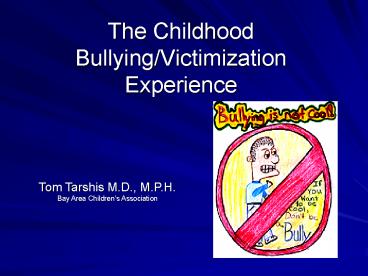The Childhood Bullying/Victimization Experience - PowerPoint PPT Presentation
1 / 18
Title:
The Childhood Bullying/Victimization Experience
Description:
More recently, recognition of other forms of bullying: Relational aggression: harming others through purposeful manipulation and damage of peer relationships . – PowerPoint PPT presentation
Number of Views:69
Avg rating:3.0/5.0
Title: The Childhood Bullying/Victimization Experience
1
The Childhood Bullying/Victimization Experience
Tom Tarshis M.D., M.P.H. Bay Area Childrens
Association
2
Introduction I
- What is bullying?
- Historically Overt aggression (hitting,
kicking, pushing) in males. - More recently, recognition of other forms of
bullying - Relational aggression harming others through
purposeful manipulation and damage of peer
relationships. - Direct and Indirect Bullying
3
Introduction - II
- Quick Definition The systematic abuse of
power - Standard definition (3 key criteria)
- The bully exhibits behavior directed towards the
victim that is designed to hurt, harm, or damage
the victim physically, socially or emotionally. - 2) The behavior only occurs when there is an
imbalance of power between the bully and the
victim (bully having more) - 3) The bullying behavior happens repeatedly over
time
4
How do we Measure Bullying?
- Self-Report
- Peer Nomination
- Teacher Report
- Parent Report
- School Reports
Issue in United States Stricter Policy on
Conducting School Research
5
Prevalence I
- United States Data
- (Nansel et al, 2001)
- In 1998, Survey completed by 15,686 students
- in 6th through 10th grades
- 29.9 with moderate or frequent involvement in
bullying - 13.0 identified as bullies
- 10.6 as victims
- 6.3 both bully and victim
- Weekly involvement
- Bullies 8.8
- Victims 8.4
6
Prevalence II International Data
Involvement in bullying more than twice during
the current school term in 25 countries
Nansel, T. R. et al. Arch Pediatr Adolesc Med
2004158730-736.
7
Prevalence III Younger Children
- N 264, Data collected from 1 public and 1
private school in CA, 1 public school in AZ - Grades 3-6, Spring 2004 In the past week..
- Bullied Victimized
- Teased 11.0 34.9
- Push, Hit 7.2 23.9
- Mean Things 11.1 37.1
8
Mental Health Correlations - I
- Being Victimized
- Depression
- Generalized Anxiety
- Social Anxiety
- Loneliness
- Low Self-esteem
- Suicidal Ideation
9
Mental Health Correlations - II
- Being a Bully
- Depression
- Suicidal Ideation
- ADHD
- Predictive of future
- adult criminal activity
10
Mental Health Correlations - III
Younger Kids (4th-6th graders)
N95 Bullies Victims Bully-Victims
Anxiety (MASC) R 0.28 R 0.32 R 0.35
Depression (CDI) R 0.49 R 0.49 R 0.57
P lt 0.01 for all associations
11
Interventions I
- True or False
There are over 300 published violence-prevention
school-based programs
True
12
Interventions II
- True or False
None of the 300 interventions meet full criteria
for being an effective evidence-based program
True
13
Interventions - III
- There are 5 interventions that ALMOST meet
criteria (possibly efficacious), just lacking
replication by an independent study group.
14
Role of Child Psychiatrist - I
- Rate of Bullying in Child Psychiatry Clinics?
- No data published - Suspect Very High
- What to do when a patient tells you they are
being bullied?
15
Role of Child Psychiatrist - II
- Assessment
- Child Parent School
- Intervention
- Child Parent School
16
Take Home Message
- Being a bully or being victimized is associated
with serious mental health consequences,
especially for children who are Bully-Victims - Future research should include finding reliable,
valid measures of bullying (direct and indirect)
and victimization and manualized and empirically
tested school-based interventions. - We need prospective studies beginning from very
young (pre-school/kindergarten) ages to track
patterns of bullying, victimization and mental
health problems over time
17
Resources
- Excellent Website
- www.StopBullyingNow.hrsa.gov
Recent Book Bullying in American Schools Edited
by Dorothy Espelage and Susan Swearer
18
- Thank you for your time!































